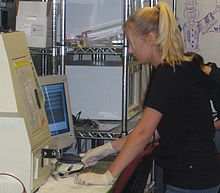Feil
| Yeged at nedon parevidön fa ek ko nivät gudik de Volapük. |
|---|

Feil länumon prodami feilaplana e nimeda, vatabrid, päskariära e fotikonöma pro prods fidik e nefidik.
- Agriculture encompasses crop and livestock production, aquaculture, fisheries and forestry for food and non-food products.
Feil äbinon jenäd cifik in jin kuliv menik seadik, lä kel farmam de bids podomöfol äjafon fidis retis kel äfägükons menis lifön in zifs.
- Agriculture was the key development in the rise of sedentary human civilization, whereby farming of domesticated species created food surpluses that enabled people to live in cities.
Du mens äprimons kädedön granis nemuiko bü 105,000 yels, farmans balik äprimons ad planön onsis züo bü 11,500 yels.
- While humans started gathering grains at least 105,000 years ago, nascent farmers only began planting them around 11,500 years ago.
Jips, kapars, svins e veter pädomöfons züo bü 10,000 yels.
- Sheep, goats, pigs and cattle were domesticated around 10,000 years ago.
Plans päbefeilons livätiko in nemuiko 11 volatopäds.
- Plants were independently cultivated in at least 11 regions of the world.
Ün tumyel 20id, feil dustodik pastabon su monobefeils gretikagredaked dareigons prodam feiliki.
- In the twentieth century, industrial agriculture based on large-scale monocultures dominate agricultural output.
Adelo, farms smaliks prodons za kildil volafida, ab farms gretik binons dareigik.
- Today, small farms produce about a third of the world’s food, but large farms are prevalent.
Gretikün 1% farmas in vol binons gretikum ka 50 tumlars e tölatons plu ka 70% volafeilaläneda.
- The largest one percent of farms in the world are greater than 50 hectares and operate more than 70 percent of the world's farmland.
Ti 40% feilaläneda patuvan in farms gretikum ka 1000 tumlars.
- Nearly 40 percent of agricultural land is found on farms larger than 1,000 hectares.
Ye, lul de alik mäl farms in vol binädon me neplu ka tel tumlars e kipon züo 12% feilaläneda.
- However, five of every six farms in the world consist of less than two hectares and take up only around 12 percent of all agricultural land.
Gretikum prodama feilavik kanons pagrupöl in fids, faibs, filamastöfs e krüdamaters (äsi gum).
- The major agricultural products can be broadly grouped into foods, fibers, fuels, and raw materials (such as rubber).
Fidaklads länumons grenaflogis (grens), härbatis, flukis, miti, miligi, e nögi.
- Food classes include cereals (grains), vegetables, fruits, cooking oils, meat, milk, and eggs.
Prodama feilavik volik suämon za 11 milbalionat touns fida, 32 balion touns natikafaibs e 4 milbalionat m3 boata.
- Global agricultural production amounts to approximately 11 billion tonnes of food, 32 million tonnes of natural fibres and 4 billion m3 of wood.
Ye, zü 14% volafuda paperon se prodam büa rivön detülaniov.
- However, around 14 percent of the world's food is lost from production before reaching the retail level.
Feilav nulädik, plantaebrid, feilakiemiks äsi pesticides e döns, e daglofs kaenavik eglofons crop yields, ab i eklebünons a däm köologik e zuämöpik.
- Modern agronomy, plant breeding, agrochemicals such as pesticides and fertilizers, and technological developments have increased crop yields, but also contributed to ecological and environmental damage.
Jok züamöpik
[redakön • redakön fonäti]Vobeds e fräds
[redakön • redakön fonäti]Feil binon bofik kodi e dasenälik a bap züamöpik, äsi per lifadistöfa, däsärtam, glunabapükam e klimatacen, kel kodon nepluikami in feilaplanaprod.
- Agriculture is both a cause of and sensitive to environmental degradation, such as biodiversity loss, desertification, soil degradation and climate change, which cause decreases in crop yield.
Feil binon bal de veütikün kodams de ped züamöpik, pato klimatacen, vatagebäd e sestralam venenöfik.
- Agriculture is one of the most important drivers of environmental pressures, particularly climate change, water use and toxic emissions.
Säkads nimeda
[redakön • redakön fonäti]Büran ela NNP, Henning Steinfeld, äsagön kel "Nimed binon bal de veütikün keblünan a säkäds fefiküns züamöpika adelo.
- A senior UN official, Henning Steinfeld, said that "Livestock are one of the most significant contributors to today's most serious environmental problems".
Nimedaprodam beseidon 70% läna pägebol pro feil, ü 30% volaläna.
- Livestock production occupies 70% of all land used for agriculture, or 30% of the land of the planet.
Binon bal gretiküna fonäta dabridöpavobeda asa gididon demü 18% dabridöpavobeda gasasestralamas
- It is one of the largest sources of greenhouse gases, as it is responsible for 18% of the world's greenhouse gas emissions.
Jafädon i 64% lamoniumasestralama.
- It also generates 64% of the ammonia emission.
Stäänükam de nimad pasaiton asa cifikafaktor säplanilama
- Livestock expansion is cited as a key factor of deforestation.
Da säplanilam e länabap, nimad ailäslonülöl lifadistöfi.
- Through deforestation and land degradation, livestock is also reducing biodiversity.
Nolavs
[redakön • redakön fonäti]Konömav feilik
[redakön • redakön fonäti]
Konömav feilik binon konomäv asa labon tefi ko "jafäd, ditibäd e konsum de dabinods e düns feilik.
- Agricultural economics is economics as it relates to the "production, distribution and consumption of [agricultural] goods and services".
Yümät feilaprodama ko teors valemik tefü selovipluükam e büsid eprimon as studajäfüd finü tumyela 19id, ed eveütikumon dü tumyel 20id.
Do stud feilakonömava äprimon tefädiko brefabüiko, klienäts veütik in feil vemiko eflunons konömis netik e bevünetiks da jenotem.
Feilav
[redakön • redakön fonäti]
Feilav binon räyun möyegädik bigik de biolog kel züon dilis kuratavis, natanolavis, konömavis e sogädanolavis pageböl in pläg e lelilam de feil.
- Agricultural science is a broad multidisciplinary field of biology that encompasses the parts of exact, natural, economic and social sciences used in the practice and understanding of agriculture.
Länumon yegädis äsi feilav, planta- e geredava-ebrid, plantamalädav, glunav, näsäkav, jafädav, dämabanimaguver, e stud de nüvobeds züamopik dämabik äsi glunabapükam e natädöpaguver.
- It covers topics such as agronomy, plant breeding and genetics, plant pathology, soil science, entomology, production techniques, pest management, and study of adverse environmental effects such as soil degradation, and waste management.
Stud nolavik de feil äprimon ün tumyel 18id, kü Johann Friedrich Mayer esperimänton ko ged de gypsum (hydrated calcium sulphate) asa döman.
- The scientific study of agriculture began in the 18th century, when Johann Friedrich Mayer conducted experiments on the use of gypsum (hydrated calcium sulphate) as a fertilizer.
Vestig evedon plu sitik kü, ün 1843, John Lawes e Henry Gilber äprimons lölädo sperimäntas fela in Rothamsted Research Station in Linglän.
- Research became more systematic when in 1843, John Lawes and Henry Gilbert began a set of field experiments at Rothamsted Research Station in England.
In Merop, Hatch Act de 1887 äkäledon füni pro kis binon balid a vokön "feilav", padugon fa nited farmana in döns.
- In America, the Hatch Act de 1887 provided funding for what it was the first to call "agricultural science", driven by farmers' interest in fertilizers.
In näsäkav feilik, USDA äprimon vestigön kontrol biologik ün 1881; ästiton program bal obik ün 1905, suköl Yurop e Yapän pro neflen natik de zigananeitapab e braunikagöba, neitapab fünöl parasitasümikis e ravamins de dämabanims bofiks in Lamerikän.
- In agricultural entomology, the USDA began to research biological control in 1881; it instituted its first large program in 1905, searching Europe and Japan for natural enemies of the gypsy moth and brown-tail moth, establishing parasitoids (such as solitary wasps) and predators of both pests in the USA.
Dunamod
[redakön • redakön fonäti]Dunamod feilik binon konlet de sluds e dunots reiganefa tefik feil domik e nüveigam de prodama feilavik foginik.
- Agricultural policy is the set of government decisions and actions relating to domestic agriculture and imports of foreign agricultural products.
Noets
[redakön • redakön fonäti]- ↑ "The Anti-Corn Law League". Liberal History. Archived from the original on 26 March 2018. Retrieved 26 March 2018.

